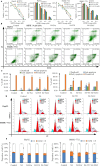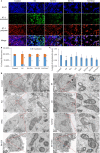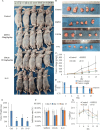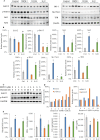Erk1/2 Orchestrates SSPH I-Induced Oxidative Stress, Mitochondrial Dysfunction and Ferroptosis in Hepatocellular Carcinoma
- PMID: 40394754
- PMCID: PMC12092237
- DOI: 10.1111/jcmm.70609
Erk1/2 Orchestrates SSPH I-Induced Oxidative Stress, Mitochondrial Dysfunction and Ferroptosis in Hepatocellular Carcinoma
Abstract
Although Erk1/2 has been linked to oxidative stress regulation in hepatocellular carcinoma (HCC), the interplay among Erk1/2, reactive oxygen species (ROS), and iron metabolism remains poorly characterised. The steroidal saponin SSPH I, a recognised ferroptosis inducer, exerts dual pharmacological effects via Erk1/2 and ROS-dependent pathways. This study aimed to investigate the regulatory mechanisms of Erk1/2 in ferroptosis and oxidative stress and analyse their feedback regulatory effects on Erk1/2 in HCC using SSPH I as a pharmacological probe, and further elucidate the anti-HCC effects and mechanisms of SSPH I in vitro and in vivo. Mechanistic studies utilised three inhibitors: U0126 (Erk1/2 phosphorylation inhibitor), Ferrostatin-1 (ferroptosis inhibitor), and N-acetyl cysteine (ROS scavenger), combined with SSPH I to delineate its effects on cell viability, mitochondrial dynamics, ferroptosis induction and oxidative stress. Mechanistically, SSPH I disrupted mitochondrial function and suppressed HCC cell survival through iron accumulation and ROS generation, while concurrently activating Erk1/2 signalling. Pharmacological inhibition of ROS or iron pathways partially attenuated SSPH I-induced ferroptosis and ROS generation, but failed to abrogate these effects. Erk1/2 inhibition completely abolished SSPH I-mediated regulation of the Nrf1/2-HO-1 axis and ferroptosis-related protein expression in cellular and animal models, identifying Erk1/2 as the upstream regulatory node. Notably, while both SSPH I and U0126 monotherapies inhibited xenograft growth, their combined use resulted in antagonistic effects. These findings establish Erk1/2 activation as the central molecular mechanism orchestrating SSPH I-driven oxidative stress amplification, mitochondrial dysfunction and ferroptosis execution in HCC.
Keywords: Erk1/2; Nrf1/2; ROS; SSPH I; ferroptosis.
© 2025 The Author(s). Journal of Cellular and Molecular Medicine published by Foundation for Cellular and Molecular Medicine and John Wiley & Sons Ltd.
Conflict of interest statement
The authors declare no conflicts of interest.
Figures







Similar articles
-
Steroidal saponin SSPH I induces ferroptosis in HepG2 cells via regulating iron metabolism.Med Oncol. 2023 Mar 28;40(5):132. doi: 10.1007/s12032-023-02000-1. Med Oncol. 2023. PMID: 36977862
-
Saponins isolated from Schizocapsa plantaginea inhibit human hepatocellular carcinoma cell growth in vivo and in vitro via mitogen-activated protein kinase signaling.Chin J Nat Med. 2018 Jan;16(1):29-40. doi: 10.1016/S1875-5364(18)30027-X. Chin J Nat Med. 2018. PMID: 29425588
-
Inhibition of STAT3-NF-κB pathway facilitates SSPH I-induced ferroptosis in HepG2 cells.Med Oncol. 2024 Jun 22;41(7):184. doi: 10.1007/s12032-024-02425-2. Med Oncol. 2024. PMID: 38909132
-
Sorafenib induces mitochondrial dysfunction and exhibits synergistic effect with cysteine depletion by promoting HCC cells ferroptosis.Biochem Biophys Res Commun. 2021 Jan 1;534:877-884. doi: 10.1016/j.bbrc.2020.10.083. Epub 2020 Nov 6. Biochem Biophys Res Commun. 2021. PMID: 33162029
-
Ferroptosis in hepatocellular carcinoma: Mechanisms and therapeutic implications.Biomed Pharmacother. 2025 Jan;182:117769. doi: 10.1016/j.biopha.2024.117769. Epub 2024 Dec 16. Biomed Pharmacother. 2025. PMID: 39689515 Review.
References
MeSH terms
Substances
Grants and funding
LinkOut - more resources
Full Text Sources
Medical
Miscellaneous

